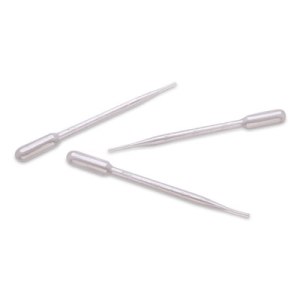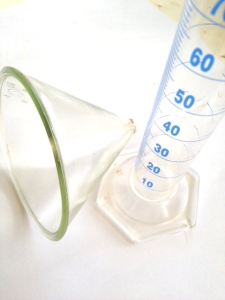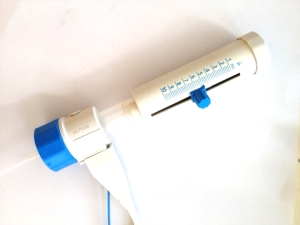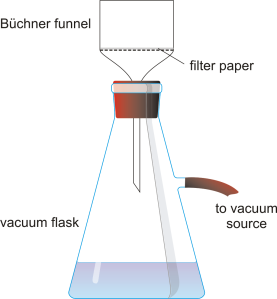Ever wondered what it takes, practically speaking, to be a perfumer?
Please, step into my office so I can show you through my (well-used) equipment…(You might need to ignore the little drips and spills!)
- Disposable pipettes
Vital for every perfumer. Allows me to draw the exact amount of extract I need accurately and hygienically every time. I buy these by the truck-load.(It’s a small truck)
- Funnels and measuring equipment
Accuracy and hygiene are very important in perfumery and cosmetics creation, so I use washable glass measuring cylinders and funnels to measure out ingredients (unless they need to be weighed) and to filter fragrances. The equipment is washed in warm soapy water and sterilised using ethanol before each use.
- Seripettor
Seri-whater, you ask? A seripettor is an amazing piece of equipment that I would not be without. It attaches to the top of a glass bottle, and very accurately dispenses our perfumes, allowing us to fill vials and bottles by hand quickly and effectively. Believe it or not, when I first started out in perfumery, I would fill every bottle and vial with a pipette!
- Buchner flask and ceramic funnel
I say its important, but I don’t actually have these as yet. These pieces of lab equipment allow for quick filtering of the perfumes without risk of flammability. Wikipedia puts it like this:
A Büchner flask can be used with a Büchner funnel for separating solids and liquids. Water is poured into the Büchner funnel and the liquid passes through filter paper and is sucked up by a vacuum attached to the side of the Büchner flask, while the solid stays behind in the Büchner funnel.
The Büchner flask can also be used as a vacuum trap in a vacuum line to ensure that no fluids are carried over from the aspirator or vacuum pump (or other vacuum source) to the evacuated apparatus, or vice versa.
The alternative to these is to filter each formulation by hand with a funnel and filter paper (which is how we do it at the moment).
- Crimper
Not all perfume companies crimp their bottles; some are screwed on. We have chosen crimp bottles with mean there is no risk of the product being tampered with, and less chance of leakages. Crimpers are not easy to find, and ours came all the way from South Africa.
A crimper like this attaches the metal atomiser to the top of the perfume bottle, and folds the metal under the lip, forming a tight seal.
- Digital scales
Most ingredients and weighed out as opposed to measured when we make our perfume blends. This allows for greater accuracy and replication of the formula each time, no matter what volume we’re making. This digital scale allows us to weigh anything from 0.1g.
- Magnetic Stirrer
A little secret weapon. Magnetic stirrers are used in chemistry for the purpose of mixing solids into liquid. A rotating magnetic field on the plate causes a little bar placed inside the bottle of perfume to spin very quickly, stirring the liquid and thus speeding up the process of ageing it. When we need to get a perfume ready quickly and don’t have the time to allow it to complete the ageing process naturally, the stirrer allows the molecules to shake, rattle and roll to achieve a synergistic blend in less time. Under normal circumstances, our perfumes mature naturally in a dark cupboard for 4-8 weeks.
Well, there you have it! The secrets to having your own little perfume studio!
Are you thinking of becoming a perfumer? Perfumer already? Whats in your lab?
Liz Cook
perfumer









Nice article Liz! Thank you for letting us in your studio:)
Do you know a supplier for the magnetic stirrer? I have been looking for one for ages but cannot seem to source one.
Isabelle
Hello Isabelle. I got mine from a lab supply store. Cost around $250 from memory. Check lab/science supply stores in your town.
What’s in my lab? Pipettes – check, funnels and measuring equipment – check, scales – check, seripettor – no – filling and filtering etc by hand. Magnetic stirrer looks awesome! I am waiting patiently for my blends to age : )
All in good time… 🙂
And I think waiting for blends to mature is the best way – a stirrer comes in handy if you need to get something finished quickly.
Hello, Liz! I also have a problem with the search crimper. At what price crimper that in your photo? It is suitable for crimping spray diameter 16mm? Thank you for share secrets!
Hello Paul
The crimper I have was around AU$700, and it comes with multiple sized heads for crimping 13mm-20mm necks.
And one more thing I would like to ask: how much time infused perfume when using a Magnetic Stirrer?
Hello again Paul 🙂
It really depends on the perfume. For most perfumes, Ive found that it can replace a month of ageing on the shelf with a week of magentic stirring. But I still prefer the old fashioned way – it’s almost as if time itself infuses into a blend 🙂
Hello, Liz! Thank you so much for this article! It is so very helpful for an aspiring perfumer, like me. I read somewhere else that smelling strips and a pH meter is also necessary. Do you use them?
Also, I don’t drink coffee – would roasted chicory serve the same function? It smells like coffee, though not as strong.
Hello paperplaneninja, and thanks for your questions!
The smelling strips are simply and absorbent paper (with no odour) on which you examine fragrances and get to know your extracts. They are a vital part of your perfumery kit. You should be able to make your own, and there are also perfumery supply websites that sell them. A pH meter is not necessary – if you need to test pH you can do it with simple pH strips from the chemist or chemical-supply store at a very low cost.
Lastly, I assume your coffee question is related to coffee beans to clear your olfactory senses? You don’t need to be a coffee drinker to use them; just buy a very small bag of them to have on hand. (Chicory wont have the same effect). Otherwise, Mandy Aftel suggests using a simple piece of wool cloth (like an old jumper) and inhale into that to clear your senses.
Happy perfuming! 🙂